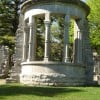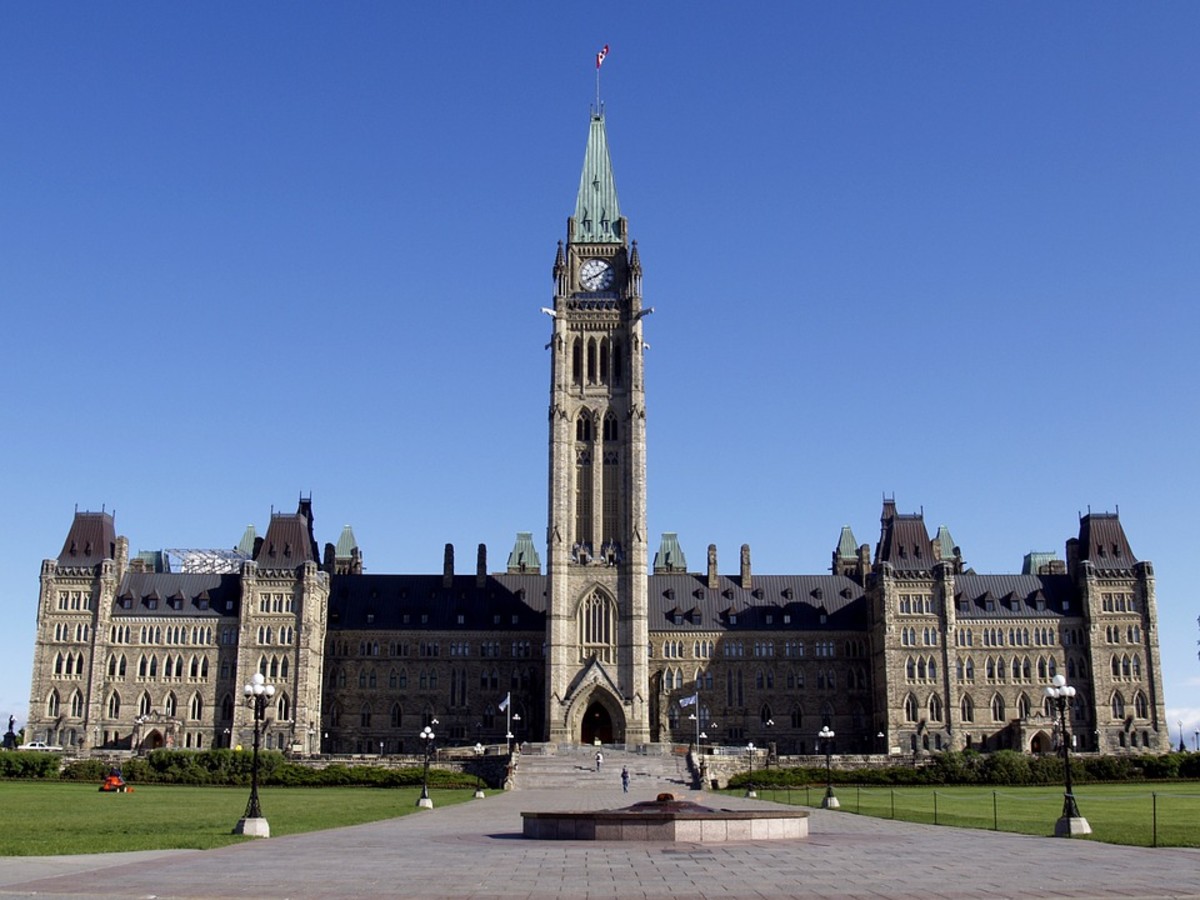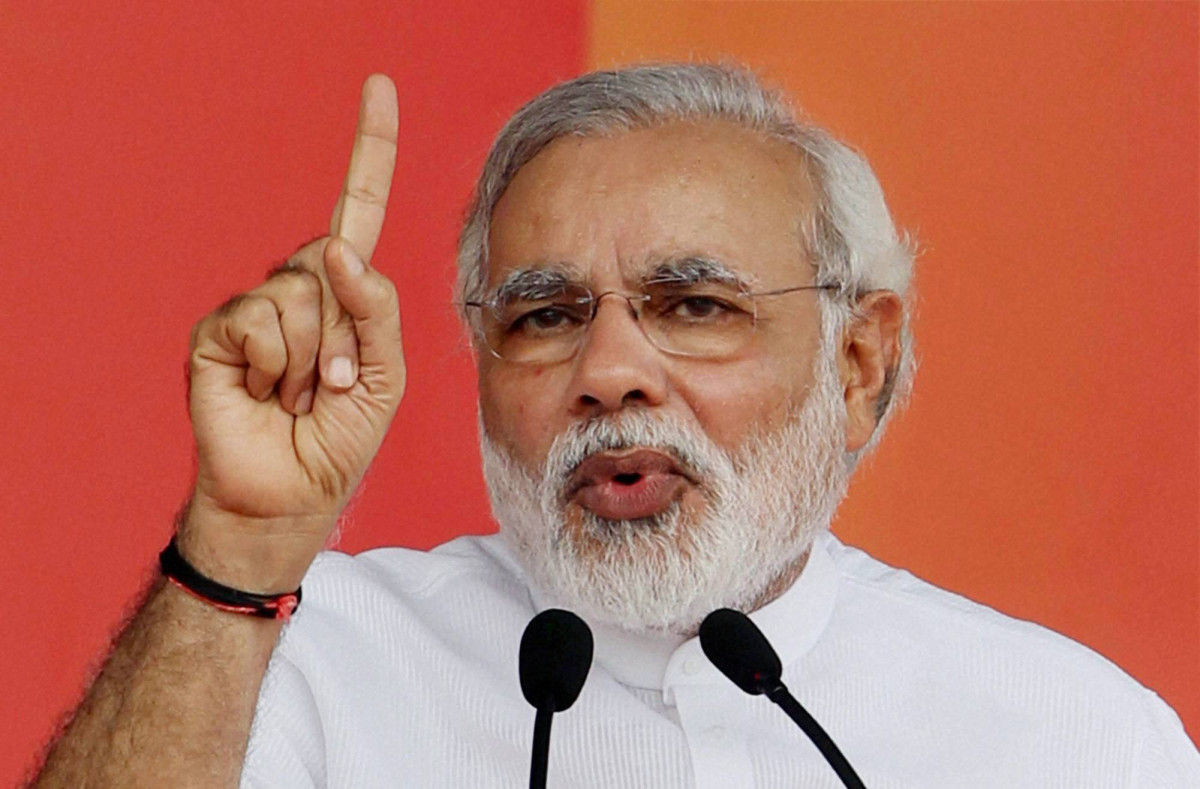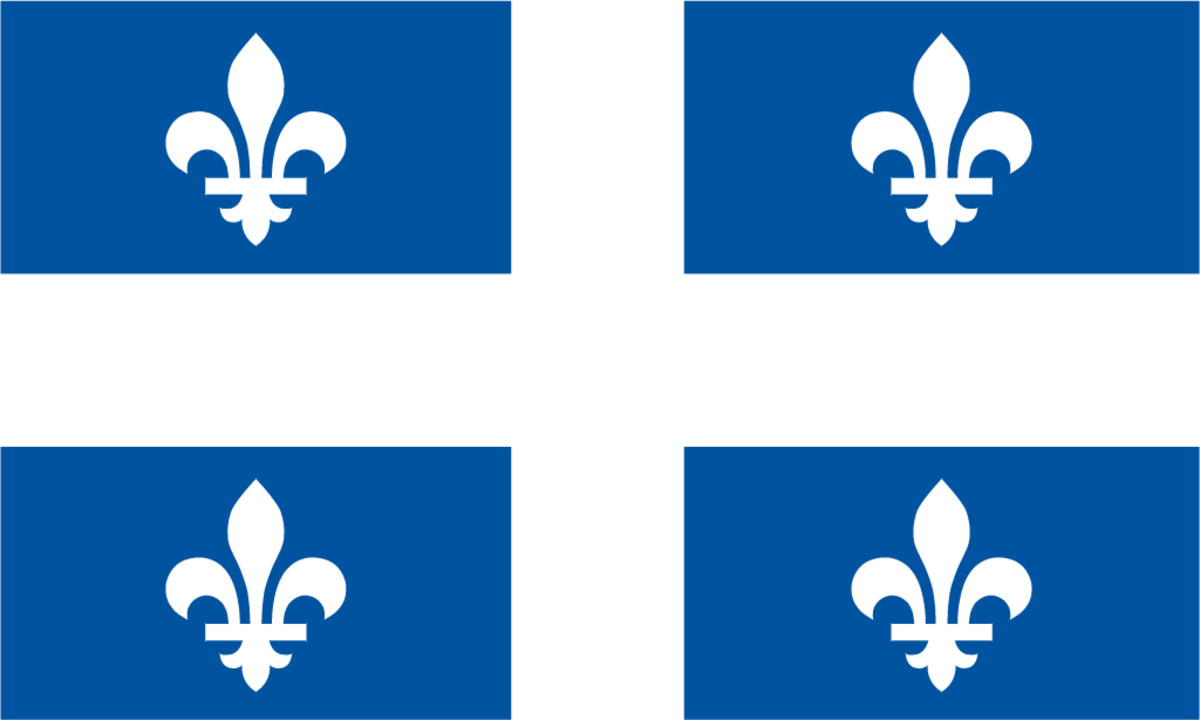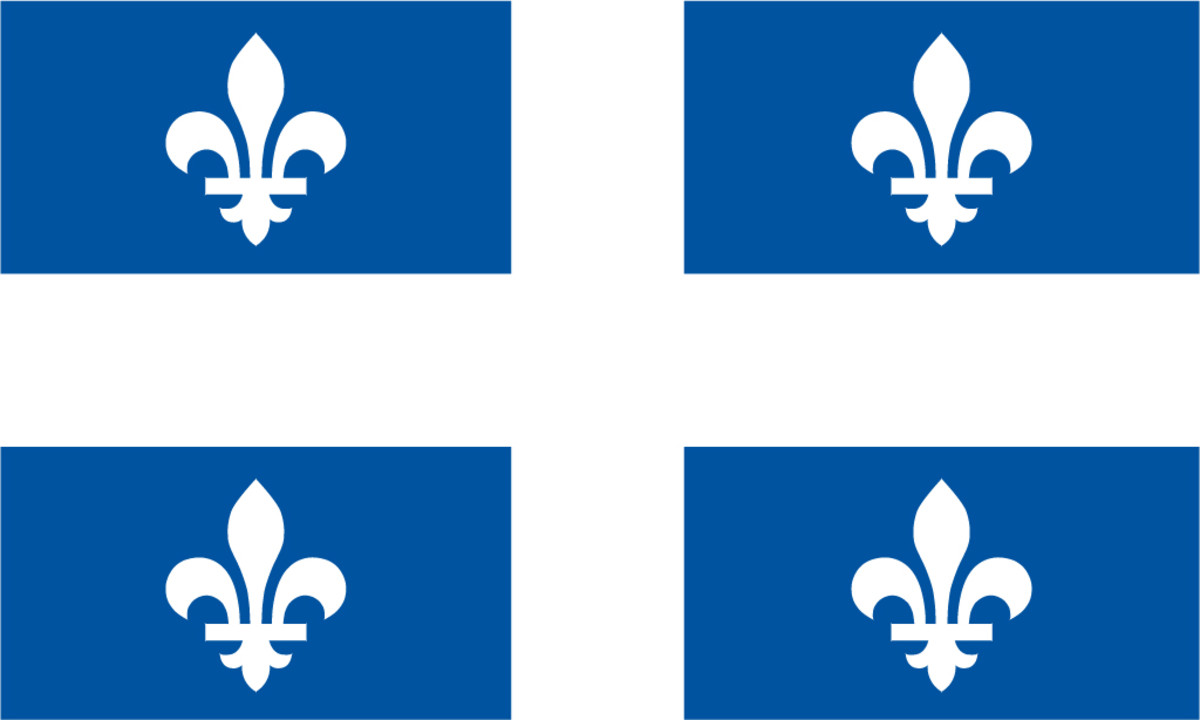Visiting the Louis S. St. Laurent House, Quebec City: former residence of a Canadian man for all seasons
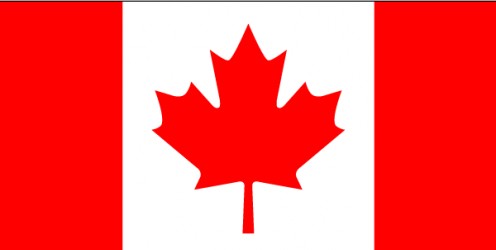

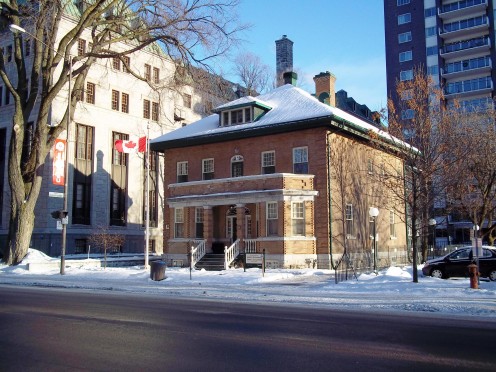
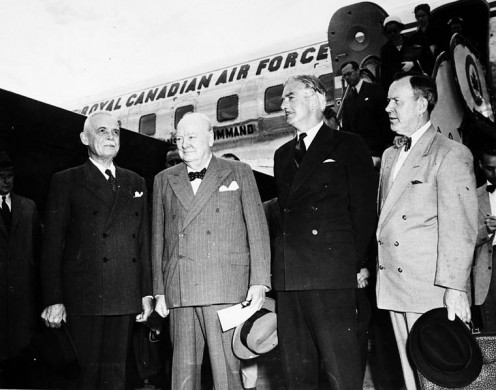
Designated a Recognized Federal Heritage Building
The full name for this property is the Louis S. St.-Laurent Heritage House (French: Maison patrimoniale Louis-S.-St.-Laurent). In addition to its associations as the residence for 60 years of the Right Honourable Louis S. St. Laurent (1882-1973), Prime Minister of Canada 1948-1957, the house at 201 Grande Allée Est, Quebec, now a museum, is interesting in its own right also.
Designated a Recognized Federal Heritage Building, its official heritage description (1) indicates that the building combines an overall architectural eclecticism and an English cottage appearance with neo-Classical elements. These elements include a striking entrance with a fanlight transom and sidelights containing stained glass.
Other features of the house include its foursquare shape, with a strong degree of symmetricality, and brick detailing, particularly on its porch pillars and second storey balcony.
The building's broader environment is significant also. Its relatively spacious setting is a reminder of the way the Grande Allée was formerly planned in a different era.
Mr. St. Laurent and his wife Jeanne Renault lived in this house in Quebec City's Montcalm disctrict from 1913.
Born in Compton, Quebec, Louis St. Laurent was a distinguished lawyer, in practice for many years in Quebec City specializing in corporate and constitutional law. In the interwar period, one of his rôles was as President of the Canadian Bar Association. He also taught law at Université Laval (where he had also graduated in 1905). In the 1930s, he served as a counsel to the Rowell-Sirois Commission investigating Dominion-Provincial relations; historian Robert Bothwell credits this period in Mr. St. Laurent's life as deepening his sense of Canadian nationalism and belief in widening opportunity throughout Canada (2).
In 1941, the death occurred of Ernest Lapointe, Minister of Justice in the government of Prime Minister William Lyon Mackenzie King (1874-1950); Minister Lapointe had also functioned as the Liberals' Quebec lieutenant. This latter rôle was — and is — a highly significant one.
What is less known is that Louis St. Laurent had already, several years previously, been invited to become Justice Minister by another Prime Minister of Canada. This offer he declined (as he did also the offer of an appointment to the Supreme Court).
In order to understand the background to Mr St. Laurent becoming Justice Minister (and to having declined this post years earlier), and entry into political life at the late age of 59 in 1941, one needs to look more closely at the circumstances of the previous, declined offer. In 1926, when Louis St.Laurent had first been offered the post of Justice Minister, the incoming Prime Minister was Arthur Meighen (1868-1960), who had already served a term as Dominion head of government in 1920-1921. Prime Minister Meighen had cut his political teeth as a Conservative in turn of the century Manitoba, when that Province's Conservatives were fiercely Anglophone and, together with the influence of Orange Lodges, had recently sought successfully to restrict French-language rights in what was known as the Manitoba Schools Question. Later, in the government of Sir Robert Borden, Arthur Meighen had served as Secretary of State of Canada, in which position he strongly promoted Conscription in Quebec, toward the end of World War One. Like Louis St. Laurent, Arthur Meighen was an accomplished lawyer; indeed, a brilliant and incisive barrister. Unlike Mr. St. Laurent, however, he was endowed with a scathing and triumphalist manner, which repelled wider audiences as much as it assisted in winning technical arguments. Louis St. Laurent was his total opposite: a man of subtlety and tact: words seldom evoked around Arthur Meighen. In hindsight, it is easy to see why the Justice Ministry offer by Prime Minister Meighen — whose second government proved to be short-lived, in any case — could not be contemplated by Mr. St. Laurent.
But this was not the outcome when Prime Minister W L Mackenzie King's offer came in 1941. He was also soon elected to a seat in Parliament. Supposedly on a temporary basis only, Louis St. Laurent joined the Federal Government, with a special rôle of interpreting Quebec's sensibilities and needs to the Prime Minister. The task was, however, not made any easier by the presence in the King Government of ministerial colleagues who expressed ideas interpreted as starkly insulting about the French Canadian military input which the Government professed to desire (3).
It was not as if Mr St. Laurent were necessarily opposed to Conscription for overseas service per se . But it was his tactful skills and peace-pursuing persona, coupled with the Liberal Party's strong, Federal vocation, that made Louis St. Laurent the ideal Quebec lieutenant for the King Government, when, at last, after a noisy and less than satisfying plebiscite in 1942, the Federal Government felt compelled to implement Conscription in late 1944, not long before the end of World War Two. Resentment in Quebec was predictably great, but there was not the level of turbulence and riots as occurred in Quebec in World War One, when Conscription was imposed toward the end of that war. In a sense, Louis St. Laurent and Prime Minister King succeeded, where Arthur Meighen and Sir Robert Borden had failed.
The efforts of a tactful peacemaker had paid more dividends than those of an Imperialist denunciator.
At the end of World War Two, the government had extremely pressing issues with which to deal; these included the founding of the United Nations Organization in 1945, and the existence of a Soviet spy ring in Ottawa, which, coming to light in 1945, gave a clue to post-War Soviet intentions: the Cold War was soon to begin. Louis St. Laurent was, in fact, a natural diplomat and in 1946, W L Mackenzie King appointed him External Affairs Minister, a position which he fulfilled until 1948. (The theory that Mr. St. Laurent had gone into politics only temporarily seemed to fade.)
In 1948, William Lyon Mackenzie King retired as Prime Minister and Liberal leader, and Mr. St. Laurent was his natural successor, who won his own very strong, Federal election mandates in 1949 and 1953.
1949 saw Mr. St. Laurent, with his own able External Affairs Minister Lester B. Pearson, lead Canada into the North Atlantic Treaty Organization. Also in 1949, he was the drafter of the London Declaration of King George VI as Head of the Commonwealth, by which newly independent Commonwealth members could remain in this family of nations, even if they ceased, as had India, to retain a monarchical system of government.
In 1950, Mr. St. Laurent led Canada, together with the United States and other countries, to war in Korea, in support of the United Nations' strictures against aggression: in common with various other world leaders, Louis St. Laurent was a strong believer that military means were necessary to counter the aggressor countries' actions.
This was also seen in 1956. Only in more recent years has the full extent of the British and French governments' deceit over their military intervention in Suez been revealed (4), but when the US Government withdrew support for their currencies, Britain and France were forced to back down. The Canadian Prime Minister, for his part, made it clear that his government could not support adventures by Colonial powers; and gave the Eisenhower Administration and the UN clear support in their opposition to British and French actions. He also strongly supported his External Minister Lester Pearson in his promotion of the UN Emergency Force, to which Canada was to contribute substantially.
Domestically, Louis St. Laurent's government was fiscally conservative; but also expanded Hospital Insurance and old age pensions, as well as family allowances and unemployment assistance. Mr. St. Laurent also had the particular pleasure of negotiating and welcoming Newfoundland into Confederation in 1949. Grants for the arts and for universities increased. The St. Lawrence Seaway, the Trans-Canada Highway, and the Trans-Canada Pipeline were all public projects which received great impetus during Mr. St. Laurent's government — though this last project, and the behaviour of his influential Minister of Trade and Commerce, C. D ('What's a million?') Howe, were to cause the Prime Minister considerable political problems.
Constitutionally, Mr. St. Laurent advised the appointment of Vincent Massey as Canada's first Canadian-born Governor-General. Further appeals to the Judicial Committee of the Privy Council of Great Britain were discontinued in 1949, making the Supreme Court of Canada, in existence since 1875, the final court of appeal. Under Equalization Payments, tax revenues were distributed to less wealthy Provinces in order to assist them in providing public services. Thus it was Louis St. Laurent who effectively slayed (or at least subdued, for Pierre Trudeau to slay nearly 30 years later) the Provincial compact theory of Confederation, which had long hindered the Federal government from carrying out many of its programs.
In 1957 Mr. St. Laurent's Liberals narrowly lost Federal elections to John G. Diefenbaker's Progressive Conservatives and the Prime Minister of nine years' standing chose to resign quietly, even though as the sitting head of government, and with the Parliamentary arithmetic such that, theoretically he could have attempted to form a coalition with a majority over the Progressive Conservatives. (In fact, the Liberals had also received a majority of the votes cast.) But Mr. St. Laurent felt that, with his own party falling short of a Parliamentary majority, Mr. Diefenbaker should be given the opportunity to try to form a government.
In 1973, Mr St. Laurent passed away at the age of 91, Mrs. St. Laurent having predeceased him in 1966. It is remarkable to reflect that this lifelong Liberal had first been active in communicating election returns in the Federal election of 1896, the year when Sir Wilfrid Laurier won over incumbent Prime Minister Sir Charles Tupper.
Naturally, in the course of a long and distinguished career, some criticism stuck. As Justice Minister he presided over the internment of Japanese-Canadians during World War Two, in circumstances when the military and the Royal Canadian Mounted Police thought it unnecessary. And while he attracted his share of intense criticism in Quebec for his part in implementing conscription in the closing months of World War Two, such opposition did not reach the acute levels of the opprobrium heaped in 1917 and 1918 upon Arthur Meighen. As Prime Minister, Mr St. Laurent undoubtedly gave the redoubtable and acerbic C D Howe too much scope to impale himself — and the Government — through Minister Howe's blundering tactic of imposing closure during the Pipeline debates. (In a less than flattering way, C D Howe, who had strongly backed Mr. St Laurent for the Liberal leadership in 1948, may thus be said to some extent both to have made, and broken, Louis St. Laurent's Federal premiership.)
In some biographical accounts Louis St. Laurent (or 'Uncle Louis' — 'Papa Louis', as he was sometimes known) it is occasionally repeated or implied that published photographs of the Prime Minister in the company of children, whether his own grandchildren, or the children of others, were somehow indicative of an electorally contrived, phoney nature. Against this, it must be remembered concerning the leaders of the Opposition of his time that George Drew was tragically haunted by his own nakedly racist comments about French Canadians (5); and the intensely partisan John Diefenbaker undoubtedly made vituperation a stock-in-trade. Thus, particular, partisan criticism of Mr St. Laurent's personal nature, finding its origins from sources close to these Opposition leaders, should be seen in this light.
The fact remains that when Louis St. Laurent led Canada, never was Canada respected more, never was Canada more influential in international affairs. If Lester B. Pearson won the Nobel Peace Prize in 1957 for his handling of the Suez Crisis, it was quite substantially because Mr. St. Laurent backed and promoted the actions of his minister. Louis St. Laurent was a responsible, North American internationalist at a time when a unilateralist foreign policy impulse was strong, south of the Border. He strengthened the Commonwealth by encouraging emerging, independent, former British colonies to remain within this family of nations and also asserted Canada's independence within the Commonwealth. A conscientious educator of Canadians as to the often stark realities of international affairs — people tended to believe that what he told them was basically trustworthy —, he presided over a period of economic growth and stability and promoted hugely significant public works which served greatly to solidify the far-flung corners of a Federal Canada. With the entry of Newfoundland, Mr. St. Laurent oversaw the enlargement of Confederation to its current size. This tactful and competent peacemaker's all-round record as Prime Minister was undeniably very distinguished, while at a personal level a modest manner and an evident love of children endeared Mr. St. Laurent to many Canadians. One could say he was a man for all seasons, who strengthened Canada.
Notes
(1) http://www.pc.gc.ca/apps/dfhd/page_fhbro_eng.aspx?id=9146
(2) Robert Bothwell, A Short History of Ontario , Edmonton: Hurtig Publishers, Ltd., 1985, p. 179.
(3) J. L Granatstein quotes Defence Minister J L Ralston's views that French Canadians would not be particularly welcome in the Canadian army in any case. Minister Ralston, who nevertheless went on to argue vehemently for Conscription, stated: 'The army would not have masses of Quebeckers under any conditions; they would not be able to do anything with them. There is only limited room in our army for these men. They can't speak English. We have no French-Canadian officers to handle them. Their fighting ability is questionable'. Qu. in: J. L. Granatstein, Who killed the Canadian Military? Toronto: Phyllis Bruce Books / HarperPerennialCanada, 2004, p. 107.
This view expressed, albeit unofficially, by the King Government's own Defence Minister, begs the question, Why would Quebeckers wish even to volunteer to fight in the Canadian armed forces (let alone be conscripted) if those in charge did not want them in any case? Such is an example from the minefield of conflicting attitudes and demands among Canadians, at a time of increasing military casualties, which Louis St. Laurent had to face at the heart of the process by which Conscription was eventually implemented.
(4) Released documents later proved that British Prime Minister Sir Anthony Eden lied to Parliament in relation to events at Suez; in any case, Sir Anthony's government's actions did not pass the 'smell test' for Mr. St. Laurent and his government.
(5) I have discussed this further in my hubpage: Visiting the Parliament of Ontario: Toronto's monumental Legislative Building at Queen's Park .
Also worth seeing
Other visitor attractions in Quebec City / la Ville de Québec itself and its environs include: the Parliament building / Hôtel du Parlement ; Château Frontenac ; the Citadel / la Citadelle ; the Montmorency Falls / la chute Montmorency , and many others.
...
How to get there: Air Canada flies to Quebec City (Aéroport international Jean-Lesage de Québec ) from Montreal and Toronto, with wide connections. VIA Rail maintains regular services with Montreal, Toronto and Windsor. A number of car rental companies offer service at Quebec City airport. Please check with the airline or your travel agent for up to date information.
MJFenn is an independent travel writer based in Ontario, Canada.
Other of my hubpages may also be of interest
- Visiting the Citadel, Quebec City: keeping watch for centuries over the St. Lawrence River
- Visiting Kipawa Lake, Laniel: boating and fishing opportunities in western Quebec
- Visiting Laurier House, Ottawa, Ontario: remembering three, not one, Canadian Prime Ministers
- Visiting Woodside, Kitchener, Ontario: boyhood home of William Lyon Mackenzie King and National Hist
- Visiting New York City: views of the Statue of Liberty, on Liberty Island
